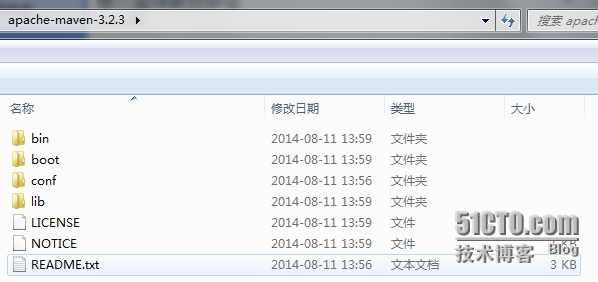第一步:添加maven支持,去Apache maven官网下载maven,
解压
在conf文件夹里有个settings.xml,这个是需要自己配置的,不然的话也会有默认,只是那样的话会在C盘了,不喜欢放在C盘,那么问题来了,需要设置的有:
localRepository:表示本地库的保存位置,也就是maven2主要的jar保存位置,默认在${user.dir}/.m2/repository,如果需要另外设置,就换成其他的路径。
<localRepository>D:Developmaven-repository epository</localRepository>
offline:如果不想每次编译,都去查找远程中心库,那就设置为true。当然前提是你已经下载了必须的依赖包。可以看到他的意思是默认会放在Default: ${user.home}/.m2/repository,这个是说从远程maven库下载的jar包依赖放在本地的位置。
Servers
在POM中的 distributionManagement元素定义了开发库。然而,特定的username和pwd不能使用于pom.xml,所以通过此配置来保存server信息
<servers> <server> <id>server001</id> <username>my_login</username> <password>my_password</password> <privateKey>${usr.home}/.ssh/id_dsa</privateKey> <passphrase>some_passphrase</passphrase> <filePermissions>664</filePermissions> <directoryPermissions>775</directoryPermissions> <configuration></configuration> </server> </servers>
-
id:server 的id,用于匹配distributionManagement库id,比较重要。
-
username, password:用于登陆此服务器的用户名和密码
-
privateKey, passphrase:设置private key,以及passphrase
-
filePermissions, directoryPermissions:当库文件或者目录创建后,需要使用权限进行访问。参照unix文件许可,如664和775
mirror:(镜像URL)
具体的maven库列表参照:http://blog.csdn.net/lifxue/article/details/7517299
这里我用的是:
<mirror> <id>ibiblio.org</id> <name>ibiblio Mirror of http://repo1.maven.org/maven2/</name> <url>http://mirrors.ibiblio.org/pub/mirrors/maven2</url> <mirrorOf>central</mirrorOf> </mirror>
Mirrors
表示镜像库,指定库的镜像,用于增加其他库
<mirrors> <mirror> <id>planetmirror.com</id> <name>PlanetMirror Australia</name> <url>http://downloads.planetmirror.com/pub/maven2</url> <mirrorOf>central</mirrorOf> </mirror> </mirrors>
-
id,name:唯一的标志,用于区别镜像
-
url:镜像的url
-
mirrorOf:此镜像指向的服务id
Proxies
此设置,主要用于无法直接访问中心的库用户配置。
<proxies> <proxy> <id>myproxy</id> <active>true</active> <protocol>http</protocol> <host>proxy.somewhere.com</host> <port>8080</port> <username>proxyuser</username> <password>somepassword</password> <nonProxyHosts>*.google.com|ibiblio.org</nonProxyHosts> </proxy> </proxies>
-
id:代理的标志
-
active:是否激活代理
-
protocol, host, port:protocol://host:port 代理
-
username, password:用户名和密码
-
nonProxyHosts: 不需要代理的host
Profiles
类似于pom.xml中的profile元素,主要包括activation,repositories,pluginRepositories 和properties元素
刚开始接触的时候,可能会比较迷惑,其实profiles是maven2中比较强大的功能。从字面上来说,就是个性配置。
单独定义profile后,并不会生效,需要通过满足条件来激活。
repositories 和pluginRepositories
定义其他开发库和插件开发库。对于团队来说,肯定有自己的开发库。可以通过此配置来定义。
如下的配置,定义了本地开发库,用于release 发布。
<repositories> <repository> <id>repo-local</id> <name>Internal 开发库</name> <url>http://192.168.0.2:8082/repo-local</url> <releases> <enabled>true</enabled> <updatePolicy>never</updatePolicy> <checksumPolicy>warn</checksumPolicy> </releases> <snapshots> <enabled>false</enabled> </snapshots> <layout>default</layout> </repository> </repositories> <pluginRepositories> <pluginRepository> <id>repo-local</id> <name>Internal 开发库</name> <url>http://192.168.0.2:8082/repo-local</url> <releases> <enabled>true</enabled> <updatePolicy>never</updatePolicy> <checksumPolicy>warn</checksumPolicy> </releases> <snapshots> <enabled>false</enabled> </snapshots> <layout>default</layout> </pluginRepository> </pluginRepositories>
releases, snapshots:每个产品的版本的Release或者snapshot(注:release和snapshot的区别,release一般是比较稳定的版本,而snapshot基本上不稳定,只是作为快照)
properties
maven 的properties作为placeholder值,如ant的properties。
包括以下的5种类型值:
-
env.X:返回当前的环境变量
-
project.x:返回pom中定义的元素值,如project.version
-
settings.x:返回settings.xml中定义的元素
-
java 系统属性:所有经过java.lang.System.getProperties()返回的值
-
x:用户自己设定的值
Activation
用于激活此profile
<activation> <activeByDefault>false</activeByDefault> <jdk>1.5</jdk> <os> <name>Windows XP</name> <family>Windows</family> <arch>x86</arch> <version>5.1.2600</version> </os> <property> <name>mavenVersion</name> <value>2.0.3</value> </property> <file> <exists>${basedir}/file2.properties</exists> <missing>${basedir}/file1.properties</missing> </file> </activation>
-
jdk:如果匹配指定的jdk版本,将会激活
-
os:操作系统
-
property:如果maven能检测到相应的属性
-
file: 用于判断文件是否存在或者不存在
除了使用activation来激活profile,同样可以通过activeProfiles来激活
Active Profiles
表示激活的profile,通过profile id来指定。
<activeProfiles> <activeProfile>env-test</activeProfile> 指定的profile id </activeProfiles>




